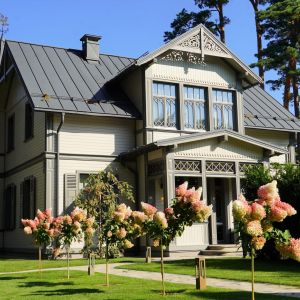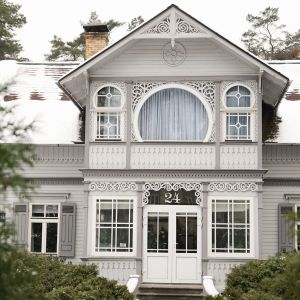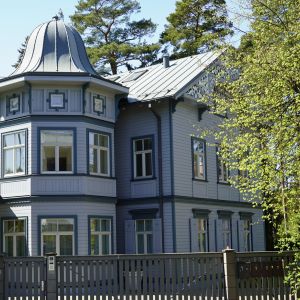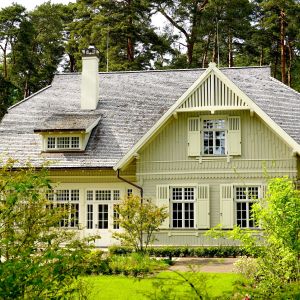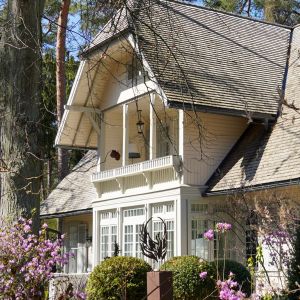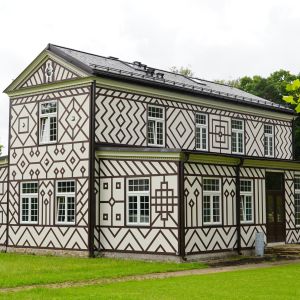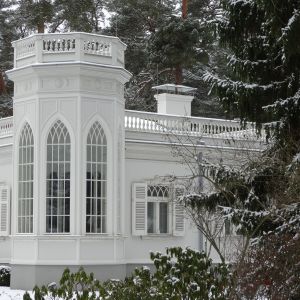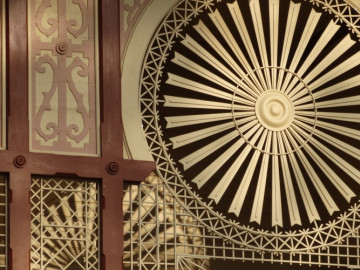The Bulduri–Lielupe Route
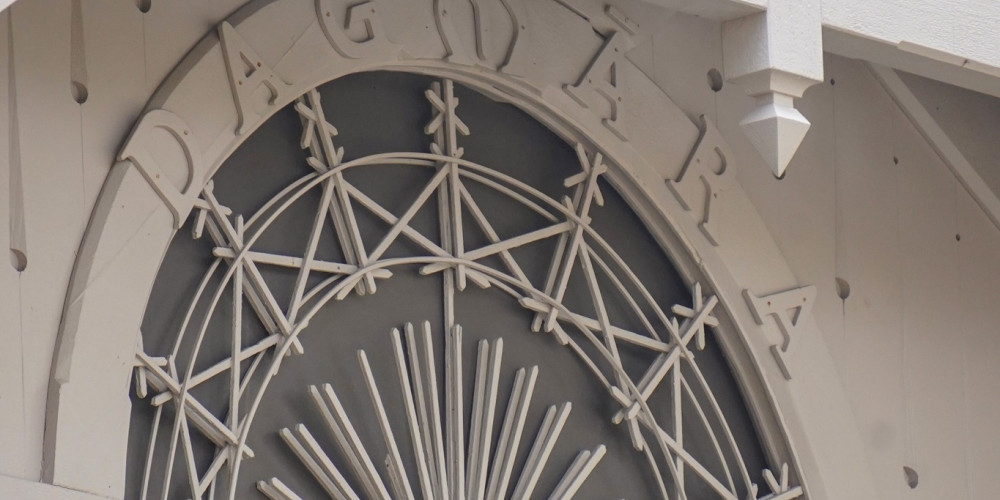
This route passes through Bulduri and Lielupe, neighbourhoods developed in the late 19th–early 20th centuries, marked by refined summer villa architecture that reflects the era’s stylistic diversity and social shifts. In Bulduri, villas with towers, glazed verandas, and intricate wood carvings line up along the avenue. Further along in Lielupe—popular with the Latvian intelligentsia during the 1920s–30s—buildings in Classicism, Neo‑Gothic, and National Romantic styles can be admired.
Route along Bulduru Prospect: starting at Krišjāņa Barona Street 4 → Bulduru Prospect 1, 7, 10, 17, 41, 53, 79, 84, 106
Route along Meža Prospect: Krišjāņa Barona Street 4 → Meža Prospect 5, 8, 14, 18, 22a, 28, 59
Supplementary along Vienības Prospect to Lielupe Station: → Vienības Prospect 24, 32 → Lielupe Railway Station
Photos: Jūrmala Cultural Space and Environmental Design Centre
Krišjānis Barons Street 4
Style: Vernacular building traditions with elements of National Romanticism
Volume composition:
- Asymmetrical volume
- Single-storey log structure
Look closer: Originally built as a forest warden’s house, this log building is atypical for Jūrmala’s summerhouse architecture. After a fire, it was restored to its original form.
Period of construction: Late 19th century
Protection status: Local architectural monument
Bulduri Prospect 1
Style: Art Nouveau with Historicist elements
Volume composition:
- Asymmetrical volume
- Mezzanine
- Two-storey polygonal tower
- Veranda
Look closer: The Art Nouveau building features a veranda with semicircular glazed windows that draws particular attention.
Period of construction: 1903
Protection status: National architectural monument
Bulduri Prospect 7
Style: Neoclassicism
Volume composition:
- Asymmetrical volume
- Two-storey wooden building
Look closer: A well-preserved example of Neoclassical architecture with a columned portico, asymmetrical composition and detailed decorative elements. One of the towers, lost during the Soviet era, has been restored.
Period of construction: Early 20th century
Protection status: Local architectural monument
Bulduri Prospect 10
Style: Historicism
Volume composition:
- Single-storey log building with dormers
- Veranda
Look closer: Dominated by an impressive covered terrace – one of the most monumental of its kind in the city. The terrace features oriental-style wooden columns in elegant contrast with the fine cast-iron lacework.
Period of construction: Early 20th century
Protection status: National architectural monument
Bulduri Prospect 17, lit. 4
Style: Historicism
Volume composition:
- Asymmetrical volume
- Two-storey wooden building
- Mansard
Look closer: The composition includes a prominent bay window with a balcony on the second floor and a central portico with columns. The façade features shutters and a restored mansard based on historical photographs.
Period of construction: Early 20th century
Protection status: Local architectural monument
Bulduri Prospect 41, lit. 3
Style: National Romanticism
Volume composition:
- Asymmetrical volume
- Single-storey wooden building
Look closer: Characterised by a striking silhouette and rich decorative details. The façade includes fine wood carvings under the eaves, rhythmic small-paned windows and wooden shutters. The roof features prominent gable ends.
Period of construction: Early 20th century
Protection status: Regional cultural monument
Bulduri Prospect 53
Style: Art Nouveau with National Romantic elements
Volume composition:
- Asymmetrical volume
- Two-storey wooden building
- Verandas
- Summer kitchen wing
Look closer: The asymmetrical structure is enriched by carved window surrounds and sculptural façades influenced by folk architecture. The highlighted gables and roof features lend dynamism to the silhouette.
Period of construction: Early 20th century
Protection status: Regional cultural monument
Bulduri Prospect 79
Style: National Romanticism
Volume composition:
- Asymmetrical volume
- Timber-frame summerhouse
- Mezzanine
- Dormer roof
- Veranda
- Loggia
- Balcony
Look closer: This building combines traditional wooden construction techniques with expressive architectural composition. The façade features rich wood carvings and eave details. The second-storey loggia is decorated with woodwork, and the broad veranda is glazed. The distinctive silhouette is enhanced by dynamic rooflines and projecting rafters.
Period of construction: 1920s (architect Gerhards Heinz Pīrangs). Restoration – 2024 (architect Uģis Zābers)
Protection status: Local cultural monument
Bulduri Prospect 84
Style: Historicism
Volume composition:
- Symmetrical volume
- Wooden building
Look closer: A small and picturesque summerhouse with a decorative appliqué on the dormer gable. The central element of the façade is a traditional Jūrmala-style veranda.
Period of construction: Late 19th century. Reconstruction – 2025 (architect Jānis Bartaševics)
Protection status: National cultural monument
Bulduri Prospect 106, lit. 6
Style: Historicism
Volume composition:
- Two-storey plastered wooden building
- Mansard floor
- Verandas
Look closer: Distinctive entrance layout and glazed verandas on the mansard level. During renovations, the original National Romantic window design was lost.
Period of construction: Around 1930
Protection status: Local cultural monument
Meža Prospect 5
Style: Historicism, Neo-Russian style
Volume composition:
- Asymmetrical volume
- Single-storey wooden building
- Mezzanine
- Verandas
Look closer: The wide mezzanine is richly decorated with wooden carvings characteristic of the Neo-Russian style. The gable features a traditional “kokoshnik” arch decoration—semi-circular, gracefully curved, and edged with a towel-end motif—particularly visible from the shoreline.
Construction period: Early 20th century
Heritage status: Local architectural monument
Meža Prospect 8 (units k‑1, k‑2, k‑4)
Style: Historicism with Art Nouveau influences
Volume composition:
- Asymmetrical volumes
- Timber-frame structures
- Towers
- Verandas
Look closer: Among the pines, expressive façades and vibrant stained-glass verandas stand out, giving dynamic character to the ensemble. The buildings share a unified architectural language, creating a harmonious aesthetic. Corner towers crowned with pointed roofs accentuate verticality, while finely carved wooden panels, floral motifs, and ornate pediments give the structures a sophisticated appearance.
Stained glass refreshes the façades and adds lightness; the large glazed modern extension mirrors the historical architecture, forming a visually compelling dialogue between old and new.
Construction period: Turn of the 19th/20th century; restoration in 2024 (architect Raivo Veisbergs)
Heritage status: Culturally valuable buildings and historic background development
Meža Prospect 14
Style: Art Nouveau with National Romanticism influence
Volume composition:
- Asymmetrical volume
- Two-storey wooden building
- Mezzanines
- Balcony
- Loggias
- Veranda
Look closer: A rarely encountered Art Nouveau building with pronounced folk craft stylization. The loggia’s carved decoration reveals National Romantic motifs that give the building a unique character. The corners incorporate cross-bearer motifs, while the intricate woodcarving on the façade and balcony balustrade underscores craftsmanship and architectural detail diversity.
Construction period: Early 20th century
Heritage status: National architectural monument
Meža Prospect 18, unit 1
Style: Historicism with Art Nouveau influence
Volume composition:
- Symmetrical volume
- Two-storey wooden building
- Mezzanine
- Verandas
Look closer: The distinctive composition is set diagonally to the street intersection, recessed into the plot, giving it a scenic presence. Polygonal tower-like verandas confer monumentality, while richly carved eaves decorate the silhouette and lighten the large structure. This building also plays an urbanistic role – placed as a corner accent to define the spatial composition of the block.
Construction period: Early 20th century
Heritage status: Regional cultural monument
Meža Prospect 18, unit k‑lit.4
Style: Historicism
Volume composition:
- Asymmetrical volume
- Two-storey wooden building
- Mezzanine
- Tower-style veranda
Look closer: Note the tower-like veranda that adds both dynamism and elegance, as well as the unusual applied gable decoration.
Construction period: Early 20th century
Heritage status: Regional cultural monument
Meža Prospect 22a
Style: Historicism, Neo-Russian style
Volume composition:
- Two-storey wooden building
Look closer: Built as a summerhouse for a Russian merchant. The façades are adorned with Neo‑Russian carved wood ornaments—rhombus friezes, stylized geometric shapes, and lace-like bands that form a rhythmic visual pattern.
Particularly notable is the gable’s wooden decoration, harmonizing geometric and stylized floral elements. Delicately carved window trims add refinement to the façade.
Construction period: 19th century
Heritage status: Local architectural monument
Meža Prospect 28
Style: Art Nouveau with Historicism elements
Volume composition:
- Asymmetrical volume
- Two-storey wooden building
- Polygonal tower
- Balcony
- Loggia
Look closer: The building is distinguished by its roof structures that give the volume a dynamic silhouette. The façade is richly embellished with carved wood details—lace-like gable trim (“ģēvelpuķes”), ornamental pediments, and finely detailed window trims.
Particularly striking are the over-window carvings and the round stained-glass window in the gable, enhancing the building’s artistic significance.
Construction period: c. 1910
Heritage status: Regional cultural monument
Meža Prospect 59
Style: Art Nouveau, Historicism
Volume composition:
- Asymmetrical volume
- Single-storey wooden building
- Mezzanine
- Four-storey polygonal tower
Look closer: The tall tower provides vertical dominance and a scenic silhouette that contrasts with the lower volume—a bold architectural presence.
Construction period: Early 20th century
Heritage status: Local cultural monument
Vienības Prospect 24
Style: Art Nouveau with Historicist elements
Volume composition:
- Symmetrical volume
- Single-storey wooden building
- Mezzanine
- Verandas
Look closer: Glazed verandas with delicate pane divisions and wooden framing are characteristic of Jūrmala’s historic wooden architecture. The façade features abundant decorative carvings—lacy bands, ornate bargeboards (“ģēvelpuķes”), and finely profiled window trims.
The central mezzanine is emphasized by a decorative semicircular opening, the focal point of the façade. The original wrought-iron fence complements the historic ensemble.
Construction period: Early 20th century
Heritage status: National architectural monument
Vienības Prospect 32
Style: Tudor style
Volume composition:
- Single-storey wooden building
- Mezzanine
Look closer: An example of faux half-timbered construction: the façade is arranged in a timber-frame grid with decorative geometric patterns, creating a visually expressive appearance.
A rare Tudor-style building in Jūrmala, reflecting the owner’s heritage. Known locally as “the Englishman’s house,” it emphasizes craftsmanship precision and architectural rhythm, creating a visually dynamic and graphic façade.
The plan is based on the Roman square module system, meaning its proportions derive from that square and its multiples. Even the deceptive half-timbered cladding is modularly patterned—every board set in relation to that system and devoid of rational ratios.
Construction period: Late 19th century
Heritage status: Local cultural monument
Lielupe Railway Station
Style: Traditional wooden station architecture with National Romantic elements
Volume composition:
- One-storey wooden building
- Station canopy
Look closer: A classic type of Jūrmala wooden station. The wide platform canopy, spanning the length of the building, is supported by wooden columns with profiled capitals and carved wooden detailing, serving both functional and aesthetic purposes.
Carvings featuring eight-pointed stars and herringbone board layouts indicate National Romantic influence. The elegantly divided windows lend airiness and balanced rhythm to the facade.
Construction period: Turn of the 19th/20th century, 1913
Heritage status: Local architectural monument
